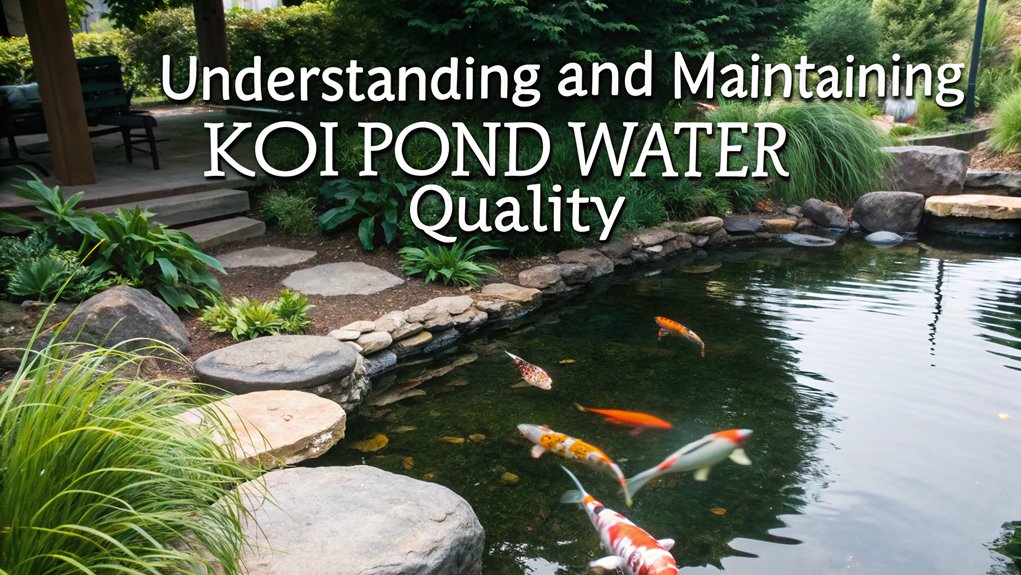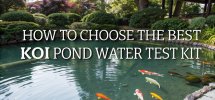Maintaining water quality in your koi pond is essential for koi health and preventing stress. Monitor ammonia (0 mg/l) and nitrate (below 20 mg/l) levels, and keep pH between 7.0 and 8.6. Make certain water temperature stays between 65°F and 75°F. Regularly change 10%-25% of the water and clean filters every 3-4 months. Evaluate source water for harmful substances like chlorine. There’s more to discover for enhancing your koi environment.
TLDR
- Regularly monitor ammonia, nitrite, and nitrate levels to prevent koi stress and health issues.
- Maintain pH levels between 7.0 and 8.6 for optimal koi health.
- Perform 10% to 25% water changes regularly to dilute harmful substances.
- Ensure oxygen levels are adequate, especially for larger koi.
- Treat new water with de-chlorinators to neutralize harmful chemicals.
Importance of Water Quality for Koi Health
When maintaining a koi pond, it’s important to prioritize water quality, as it’s the primary environmental factor influencing koi health. Elevated ammonia levels beyond 0.15 ppm are toxic, causing stress and compromising koi health. Make sure ammonia remains at 0 mg/liter to prevent lethargy and loss of appetite.
Regular water changes are crucial, replenishing trace elements and promoting a balanced ecosystem. Maintaining pH levels between 7.0 and 8.6 prevents stress and infections, essential for koi vitality.
Adequate oxygen levels are necessary, as larger koi demand more oxygen, and deficiencies result in gasping behaviors. Employ a robust filtration system and encourage beneficial bacteria to maintain water quality, thereby minimizing stress and enhancing overall koi health.
Key Water Quality Parameters to Monitor
To guarantee ideal koi health, you need to monitor several critical water quality parameters with precision and regularity.
Begin by checking ammonia levels, ensuring they remain at 0 mg/liter, as any presence can be toxic to koi, causing stress and health problems.
Similarly, nitrite levels must be at 0 mg/liter to prevent koi discomfort such as flashing and clamped fins.
Maintain nitrate levels below 20 mg/liter; levels above 60 mg/liter are harmful.
The pH level should stay between 7.0 and 8.6 to avoid infections.
Consistent koi pond maintenance includes managing water temperature between 65°F and 75°F.
Use biological filters to manage fish waste, which directly affects these parameters, ensuring healthy koi and ideal pond conditions.
Signs of Poor Water Quality in Your Koi Pond
Monitoring key water quality parameters guarantees your koi pond remains a healthy environment for its inhabitants, but identifying signs of poor water quality is just as important.
Recognizing fish distress behaviors is vital for safeguarding the health of your Koi. Elevated levels of harmful ammonia or nitrite necessitate prompt water changes. Conduct regular water tests to detect these toxic compounds early.
Look for these signs:
- Behavioral Changes: Laying on the bottom or difficulty swimming indicate stress.
- Appetite Loss: A prolonged lack of appetite signals unhealthy pond conditions.
- Surface Gasping: This suggests low dissolved oxygen or high toxic compound levels.
- Water Appearance: Foamy or yellowish water implies nutrient excess or chemical imbalance.
Act swiftly to address these issues and maintain ideal water quality.
Effective Water Maintenance and Cleaning Practices
Guaranteeing effective water maintenance and cleaning practices is essential for sustaining a thriving koi pond. Regular water changes, ranging from 10% to 25%, are critical to diluting harmful substances, thereby preserving good water quality.
Employ a test kit to consistently monitor pH levels, making certain they stay between 6.5 and 8.5, and keep ammonia levels at 0 mg/l.
Koi Pond Care involves systematically removing debris and fallen leaves to prevent nutrient buildup. Clean filters and settling tanks every 3 to 4 months, and inspect skimmer baskets weekly for ideal filtration.
Introduce fresh water using a de-chlorinator like AmQuell+© to neutralize harmful chemicals. These practices promote a balanced ecosystem and guarantee your koi pond remains a healthy habitat.
Evaluating and Managing Source Water
Maintaining a balanced koi pond ecosystem requires a keen understanding of the quality of your source water, an often-overlooked factor.
Municipal water frequently contains chlorine and chloramines, harmful to koi. Evaluating water quality through routine testing is essential to identify contaminants from various sources, including surface and well water.
- Monitor Alkalinity and pH: Regular checks can highlight the need for water changes to stabilize the pond ecosystem.
- Detect Heavy Metals: Test for copper, zinc, and lead, as these can leach from system hardware and pose toxicity risks in low pH conditions.
- Implement Routine Testing: Identifying bacteria or chemical contamination guarantees a safe environment for your koi.
- Schedule Regular Maintenance: Consistent system checks mitigate source water issues, supporting a healthy pond ecosystem.
Seasonal Adjustments for Optimal Pond Care
As the seasons shift, adapting your koi pond care strategies is essential to guarantee a thriving aquatic environment year-round. Implement seasonal adjustments to sustain water quality and fish health. In summer, increase water changes up to 25% to control temperature and algae growth. Conduct pH testing and monitor ammonia levels. In fall, trim plants and consider professional pond cleaning. Winterize by turning off fountains and using a de-icer for ideal aeration. Spring calls for replacing filters and gradual water changes, moving koi to warm-season foods.
| Season | Key Actions | Purpose |
|---|---|---|
| Summer | Water changes, pH testing | Manage algae, ammonia |
| Fall | Plant trimming, cleaning | Prevent debris buildup |
| Winter | De-icer installation | Maintain oxygen levels |
| Spring | Filter replacement | Establish ecosystem |
Consistent pond maintenance guarantees balanced water conditions.
Frequently Asked Questions
How to Keep Koi Pond Water Healthy?
To keep koi pond water healthy, regularly test for ammonia, nitrite, and nitrate levels. Maintain a pH between 7.0-8.6. Conduct 10-20% water changes biweekly. Guarantee adequate aeration and keep filters clean for ideal conditions.
How to Improve the Water Quality of a Koi Pond?
To improve koi pond water quality, you should test parameters regularly, conduct partial water changes, and implement efficient filtration. Guarantee proper aeration and debris removal. These steps optimize conditions for beneficial bacteria and prevent harmful compound buildup.
How Do I Keep My Koi Pond Water Crystal Clear?
Test regularly, filter efficiently, aerate consistently, and change water periodically. These practices guarantee crystal-clear koi pond water. Analyze ammonia, nitrite, and pH levels, dilute toxins with partial changes, and use aeration to boost oxygen for clarity.
What Should the Water Quality Be in a Koi Pond?
You should guarantee your koi pond’s pH stays between 7.0 and 8.6. Maintain ammonia and nitrite levels at 0 mg/l. Keep nitrates between 20-60 ppm. Monitor water temperature, aiming for 65°-75°F for ideal koi health.
Conclusion
You’ve learned the essentials of maintaining ideal water quality for your koi pond. But will you recognize the early signs of imbalance before it’s too late? By regularly monitoring key parameters and adjusting for seasonal changes, you guarantee a thriving environment for your koi. Use research-based insights to evaluate your source water and implement effective maintenance practices. With diligence, your pond will be a vibrant, living masterpiece, reflecting your commitment to aquatic health.


